ioSafe SoloPRO: Disaster Proofing Your Storage Needs
by Ganesh T S on April 9, 2012 6:00 PM EST- Posted in
- Storage
- IT Computing
- ioSafe
ioSafe holds a number of patents related to disaster proofing of digital storage media. ioSafe's CEO Robb Moore is the primary inventor of most of those patents. In this section, we will take a brief look at the various patents related to the ioSafe SoloPRO. Note that the SoloPRO might not be using all of the inventions mentioned in the patents below.
Fire Resistant, Forced Air Cooled Enclosure for Computer Digital Data Storage Device (US Patent No. US 7,211,742 B2):
This patent provides details of how ioSafe is able to design a fireproof enclosure despite the presence of a fan to cool the operating contents. Even though a single hard disk drive used as a backup target (such as in the SoloPRO) might not require active cooling, it is definitely a necessity in multi-disk configurations.
The invention presents a fireproof enclosure with an inlet for air to flow through (aided by a fan) and cool the storage device inside. However, this inlet could prove detrimental in case of a fire (where the exposure of the internal storage device to high temperatures / fire through the inlet could cause its destruction).
To solve this problem, the opening is protected by a fire resistant movable hatch. This movable hatch automatically closes upon reaching a predetermined temperature (which is something not reached by the drives during operation, and also below something which can actually damage the drives). The closing mechanism could use any temperature sensitive element (eutectic metal / plastic / rubber / wax etc.) coupled with either actuation springs that expand or contract to close the hatch or just rely on gravity to bring the hatch down (if the temperature sensitive element is actually supporting the top of the enclosure). An alternative to a mechanical closing system is an electronic solenoid based system where the actuator is a thermocouple.
Example of springs being used as actuators to close hatch held in place by a temperature sensitive element (Diagrams from Patent No. US 7,211,742 B2). Note that this is not the actual mechanism used in the SoloPRO.
In each of the above methods, a temperature sensitive element is activated when a threshold temperature is reached, which protects the internal data storage device from the high external temperature.
Fire Resistant and/or Water Resistant Enclosure for Operable Computer Digital Data Storage Device (US Patent No. US 2009/0050365 A1):
This patent details inventions which provide for hatchless enclosures (with or without fans), water resistant and non-actively cooled enclosures (with or without hatches), and enclosures with meltable materials which can close off ventilation passageways in the case of a fire.
The movable hatches described in the previous patent tend to increase the cost of the device. In this patent, ioSafe describes how a 1.5 inch thick gypsum wall with small sized vents could support fan-based cooling while also protecting the internal contents from the high temperatures outside. In the presence of a fire, the air inside expands and gets forced out through the vents. This outward air flow counteracts the flow of external heat through the vents. The vents are designed to be maze-like to reduce the amount of external heat which can get inside. Of course, the inner chamber and the vents have to be appropriately sized to provide fire resistance and prevent data loss.
Labyrinthine vents to allow for expanding internal air volume to counter the external heat (Diagram from Patent No. US 2009/0050365 A1)
The SoloPRO is also water resistant, and this patent also describes the water resistant and heat conducting covering for the data storage device. In addition, the patent also presents how intumescent or meltable materials can be used to seal off the inlets for the power and data cables of the data storage device.
Water resistant pouch with an embedded finned heat sink to cover the storage media. Note that the SoloPRO's water resistant pouch doesn't have a finned heat sink (Diagram from Patent No. US 2009/0050365 A1)
The water resistant pouch is made of heat conducting material so that the heat produced by the drive is taken away. It could be either a metallic foil or a more rigid enclosure. The enclosure could also internally contain fins for better thermal performance. The metallic pouch is provided with an elastomeric coating. A gasket around the perimeter of the pouch provides a water resistant enclosure.
Fire Resistant and Water Resistant Enclosure for Operable Computer Digital Data Storage Device (US Patent No. US 7,843,689 B2):
This patent is the one on which a majority of the features of the SoloPRO are based. It improves upon the inventions detailed in the previous two patents by:
- Super-saturating the enclosure (made of gypsum or concrete) with water, and preventing its evaporation with vapor barriers on both the internal and external walls of the enclosure (during a fire, this barrier melts and the water in the walls absorb the latent heat of vaporization, allowing the extension of the time over which the internal storage device is protected from damage).
- Not allowing the movable hatch design to completely close off the internal unit, but allow a slight opening for superheated steam to escape (can be used for high power devices - 20 to 2000 W)
- Providing ventilation passageways for expanding air and steam inside the unit in case of a fire (in hatchless designs)
State of the enclosure prior to fire exposure. Note the size of the vents near 91 and 92 which allow for flowing air to cool the storage media during normal operation (Diagram from Patent No. US 7,843,689 B2)
State of the enclosure after fire damage. Note that the size of the vents near 91 and 92 have decreased, but they still allow steam built up internally to escape outside (Diagram from Patent No. US 7,843,689 B2)
The water resistant pouch used in this invention is similar to the one in the previously described patent.


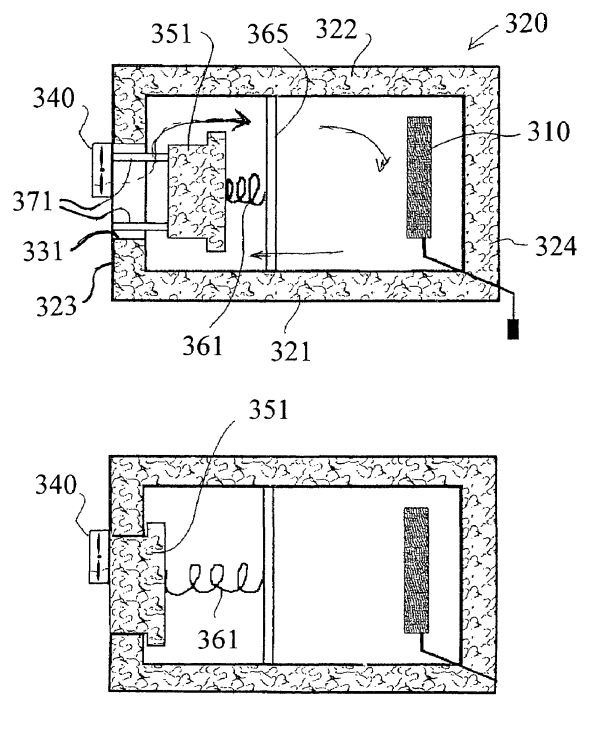
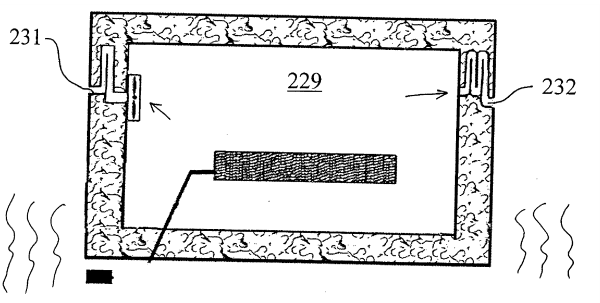
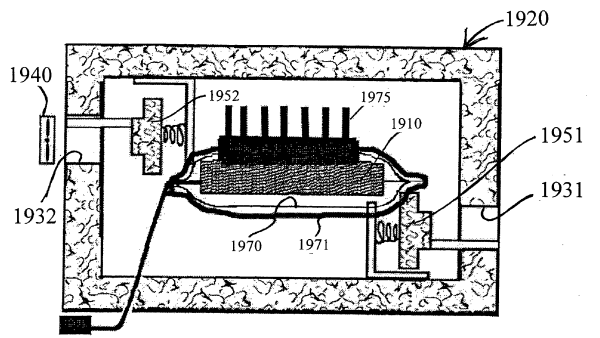
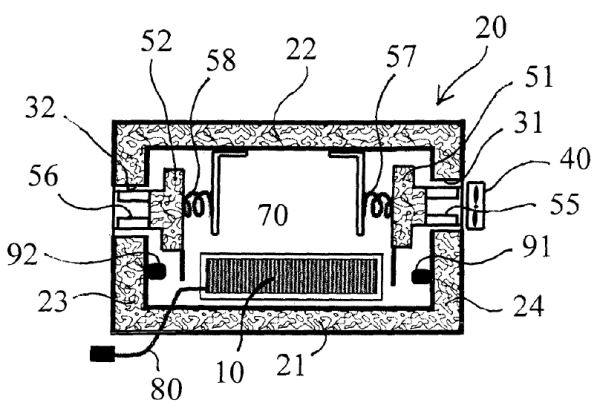
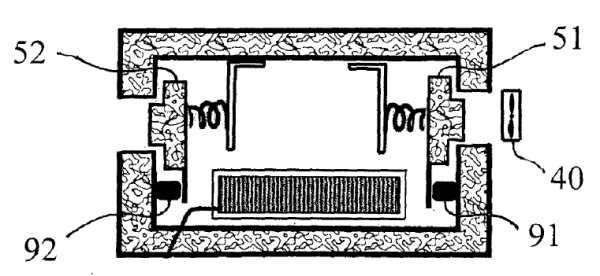








34 Comments
View All Comments
ant6n - Monday, April 9, 2012 - link
Most of the inventions related to cooling the drive while fire/water-proofing will be moot once SSDs get cheaper. Maybe they should focus on finding ways to redundantly store data in SSDs in a fire/water proofed way.ganeshts - Monday, April 9, 2012 - link
ioSafe has a disaster proof SSD solution also. Why do you think fire/water proofing is not necessary for SSDs?bji - Monday, April 9, 2012 - link
I think you misunderstood the comment.The comment was that COOLING THE DRIVE is not necessary for an SSD which makes it easier to develop fire/water proof solutions based on SSDs.
The comment was NOT that fire/water proofing is not necessary for SSDs.
B-Unit1701 - Tuesday, April 10, 2012 - link
I would imagine that is the basis for the internal drive plugged at the end of the article. A standard sized SSD in a 5/12" vault.PostToaster - Tuesday, April 10, 2012 - link
bji -
Mmh didn't misunderstand your comment. You mis-wrote it. You should have said "trivial" instead of "moot". They mean different things.
robb.moore - Tuesday, April 10, 2012 - link
Hi bjl-Cooling electronics is always important as HDDs, like SSDs, all generate heat. SSDs generally do generate less heat than HDDs at idle but when operating - they both use about 4-5W of energy. Even 1W in a small enough enclosure can get incredibly hot if insulated.
ioSafe technology is about how to built a heat generating computer in a perfectly insulated box. It's tricky to do both at a price point that everyone can afford. Thanks for your comments!
-Robb
Robb Moore
CEO
ioSafe
Samus - Thursday, April 12, 2012 - link
I agree. 5-watt SSD's get pretty hot, you can't just put them in an air-tight enclosure. I've read a number of stories involving OCZ's drives (among the highest wattage drives) failing in laptops, especially older Thinkpad's that were designed for 4200RPM drives.g00ey - Thursday, April 12, 2012 - link
I'm still concerned about the integrity of data storage. It is a well known fact that storage devices are prone to failure no matter how fire- and waterproof you make them. This means that some form of redundancy is required and at the moment only ZFS can deliver proper protection against data corruption.File systems such as BrtFS and HammerFS look promising but it will take years until they can deliver the same data integrity protection as ZFS currently does.
robb.moore - Thursday, April 12, 2012 - link
Agreed - redundant copies of the data is VERY important. (See 3-2-1 Backup in the comments further down.)The simple choice with ioSafe is that if you're going to buy an external hard drive anyway...would you like the RED hard drive or the FIREPROOF WATERPROOF hard drive for your data.
-Robb
Robb Moore
CEO
ioSafe
JNo - Monday, April 9, 2012 - link
Off site cloud storage (as well as onsite secondary backup system) is surely the way to go? Onsite backup can burn down too but one or more cloud systems are unlikely to go down simultaneously. Now if only it was cheap enough to back up my movie collection as well as my documents :)